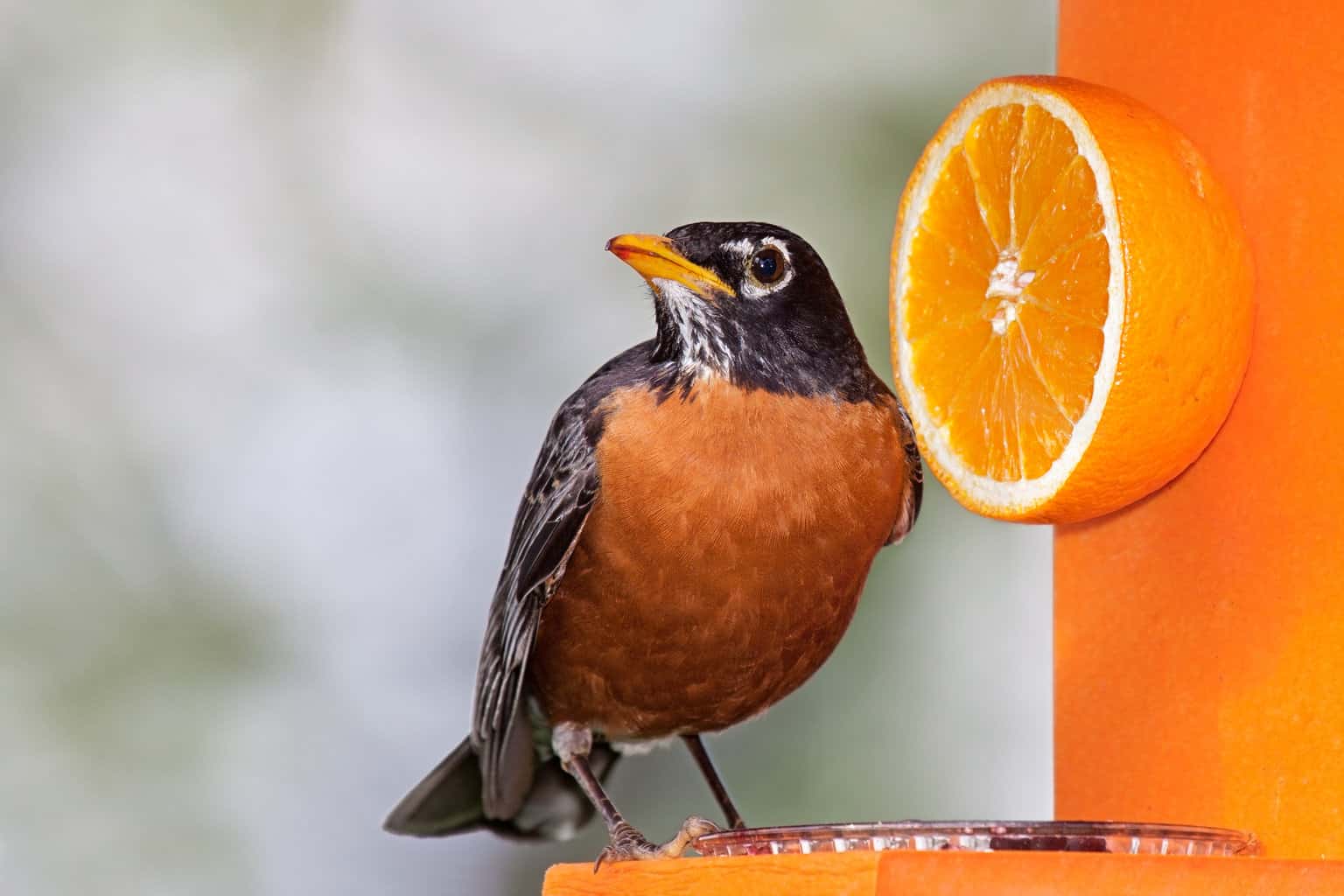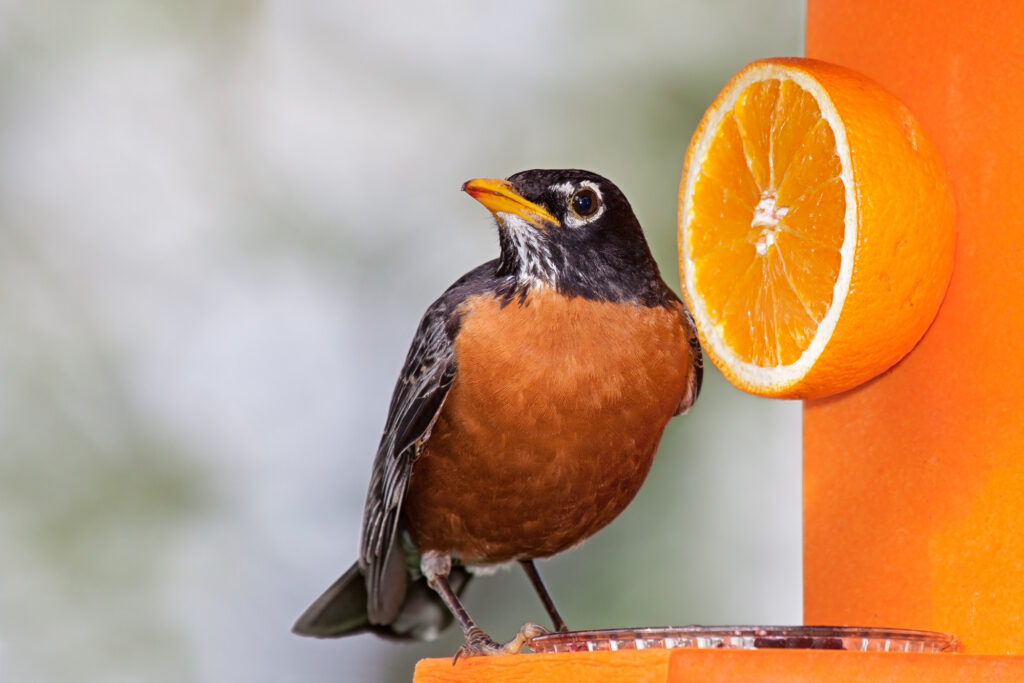Many of our feathered friends love fruit, but can birds eat oranges?
In short: Yes! Wild birds can absolutely eat slices of oranges. If you’re looking to add a little citrus and vitamin C to your feeders or bird table, here’s a quick guide.
What Birds Like Oranges?
Most backyard bird watchers put out oranges in hopes of attracting orioles.
Baltimore orioles are the most common oriole across most of the United States, with a range that stretches from the Great Plains to the entire eastern United States. Orchard orioles also occupy a similar range.
Residents of various western locations may see Scott’s orioles, Bullock’s orioles, Hooded orioles, and residents of southeastern Texas could catch a sight of the Audubon’s oriole or Altamira oriole.
The spot-breasted oriole’s range includes western Florida as well.
While orioles are perhaps the bird most commonly associated with feeding oranges, other birds like woodpeckers and grosbeaks may enjoy citrus fruit as well.
How Should I Prepare Oranges for Birds?
One of the nice things about feeding wild birds oranges is that it doesn’t take a lot of work on your end.
You simply just cut an orange in half to give the birds easy access to the juicy inner parts of an orange, not the orange peel.
Leave the peel on and stick half of the soft wedges side up on anything that will hold it up straight in an area—like a bird table—where birds can easily find it—as an occasional treat.
This could be as simple as sticking your orange upright on a fence post, stick, or skewer, or even just sticking an orange half on your regular bird feeder, though spreading out your bird food offerings among multiple feeders can help reduce the spread of disease.
Some companies do make orange-specific bird feeders if you wish. Feeders that hang upright and hold the oranges on their side perpendicular to the ground are great, but they’re not absolutely necessary. Bird tables work just fine!
How Often Do I Need To Add a New Orange?
This depends mainly on how many birds frequently feed on your yard’s oranges. With several birds visiting frequently, orioles can tear through the fleshy parts of an orange fairly quickly.
When all the fleshy parts of your orange are gone, it’s time to switch out the fruit for birds. The birds won’t eat the peel, or any other parts of the orange, such as leaves.
There is perhaps such a thing as too much of a good thing. While oranges are packed with nutrients, they are acidic and high in sugar content. There’s no exact way to know how much is too much for the birds in your yard, but if you feel like you’re putting out new oranges constantly, feel free to take a short break.
Does It Matter What Kind of Fresh Orange I Put Out?
It doesn’t matter what kind of orange you put out, whether that’s clementines or mandarin oranges. They both have dietary fiber and essential nutrients!
What About Freeze-Dried Oranges, Orange juice, or Frozen Orange Concentrate?
You should not put out orange juice concentrate or orange juice for birds.
In addition to containing extra processed ingredients that birds don’t need, concentrate and orange juice can be messy, and sticky wings can be bad news—and sometimes silent bird killers. Wet, sticky wings can make it difficult for birds to fly.
Generally, freeze-dried fruits are okay for birds. Many birds like robins are known to enjoy raisins.
That being said, the birds in your backyard are more likely to be drawn in by a large, juicy orange than a pile of freeze-dried oranges.
When Should I Put Out Oranges?

You can put out oranges at any time that birds are present that eat oranges. If it’s just orioles you’re looking to feed, pay attention to when orioles are migrating to and from your area.
In most northern areas, orioles will arrive between April and May, and they could start to head south as early as July, according to the Cornell Lab of Ornithology.
Some orioles will spend the winter in Florida, but most head further south to the Caribbean, Central, and Southern America.
If you have woodpeckers, robins, or other birds that hang around all year long in your yard that visit your orange feeders, you can put out oranges throughout the year.
Do Birds Eat Other Fruits?
Many birds like fruit, and you can try to put out any other fresh, unprocessed fruit for your backyard birds such as apples or melon chunks. They’re a great source of vitamins!
If the birds don’t take to it, make sure to go and retrieve it before it starts to rot and attracts bugs and other pests.
What Else Do Orioles Eat?
Fruit is a natural part of an oriole’s diet. Orioles feed on wild fruits like wild cherries or mulberries, in addition to bugs such as beetles, grasshoppers, and spiders, according to the National Audubon Society.
Because they don’t eat seeds, you are not likely to see orioles at your traditional bird feeders.
Some people also supplement orioles’ diets with grape jelly which contains valuable vitamins.
Some companies sell natural jelly without preservatives or artificial sweeteners, but any natural jelly from your fridge made without artificial sweeteners will do the trick.
How Often Do I Need To Clean My Bird Feeders?
As you probably know, fruit juice can be sticky.
It’s important to wash all of your feeders regularly in order to reduce the spread of disease, but you may want to wash any feeders that hold fruit even more frequently.
The Cornell Lab of Ornithology suggests cleaning feeders at least once every two weeks, and more often during wet periods or if there have been sick birds in your area.
You can clean your feeders in the dishwasher or with soap and water, then use a 10% bleach solution.
Make sure to rinse off all bleach and dry your feeders well before putting the feeders back out for birds.

